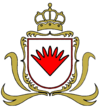Kingdom of Sedakania: Difference between revisions
Jump to navigation
Jump to search
Neuleinster (talk | contribs) No edit summary |
Neuleinster (talk | contribs) No edit summary |
||
| Line 1: | Line 1: | ||
{{Infobox former country | {{Infobox former country | ||
|native_name =Królestwo Sedacani ([[Sedakanian]])<br/>Königreich Sedakanien (Besmenian)<!-- Name in a modern syntax of native language(s). Leave blank if name is only in English. | |native_name =Królestwo Sedacani ([[Sedakanian]])<br/>Königreich Sedakanien (Besmenian)<!-- Name in a modern syntax of native language(s). Leave blank if name is only in English. | ||
Revision as of 13:50, 28 December 2020
Kingdom of Sedakania Królestwo Sedacani (Sedakanian) Königreich Sedakanien (Besmenian) | |
|---|---|
| 1600–1921 | |
| Kingdom of Sedakania from 1600 to 1810 Kingdom of Sedakania from 1600 to 1810 | |
| Capital | Treimar (1600-1627) Lichtenberg (1627-1688) Helmfurt (1688-1921) |
| Common languages | Sedakanian, Besmenian |
| Demonym(s) | Sedakanian |
| Government | Absolute monarchy (1606-1810) Constitutional monarchy (1793-1921) |
| King | |
• 1600-1639 (first) | Johannes V |
• 1899-1921 (last) | Ludwig II |
| Governor general | |
• 1810-1812 | Bernd Kraut |
| Sedakanian Minister | |
• 1813-1823 (first) | Karl von Ernst |
• 1920-1921 (last) | Hugo Beetham |
| History | |
• Independence from the HAE | 1600 |
| 1807-1810 | |
• Integration to the Kingdom of Besmenia | 1 January 1813 |
• Abolition of the monarchy | 14 October 1921 |
| |
The Kingdom of Sedakania was a small state in Belisaria, which existed as an independent state from 1600 to 1810 and as a protectorate and later as a province of the Kingdom of Besmenia from 1810-1921.
The kingdom gained with Besmenia independence from the HAE in 1600. In the Besmenian-Sedakanian War, Sedakania had to fight for its independence, which however lost the war. After the kingdom was a protectorate of the Kingdom of Besmenia from 1810-1812, Sedakania received the status of a province on January 1, 1813. When Karl Ochsenbein came to power on October 11, 1921, the monarchy was abolished.

